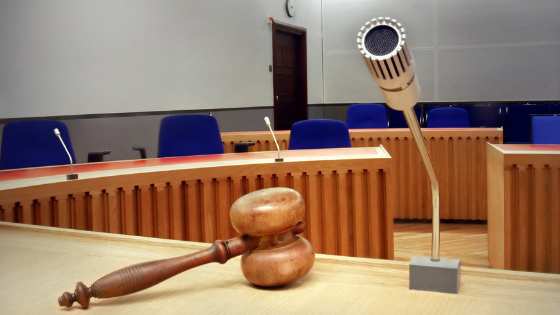The judge’s bench is a primary element of courtroom design. The bench is usually elevated as a prominent central feature at the front of the courtroom. However, there is an emerging architectural movement to design more open and user-friendly courthouses. Why not consider lowering the judge’s bench so it becomes a less intimidating, more user-friendly feature in the courtroom?
Reasons for Elevating the Bench
Over the past 30 years, I have worked with numerous courthouse design standards, and nearly all of them specify that the judge’s bench is to be elevated two or three steps above the courtroom floor. There are several key reasons to elevate a judge’s bench.
Sightlines
Since judges oversee court proceedings, they need to have clear sightlines to all parties in the courtroom. This is both a practical matter as well as a security matter. Practically, a judge must ensure that all court participants follow procedures. Thus, a judge must be able to see participants at the jury box, witness stand, attorney tables, court staff workstations, and security personnel stations. Having an elevated bench provides the judge with sightlines so that all parties are in view. In addition, the judge should be able to see the spectators in the courtroom to ensure they follow court procedures and do not distract participants.
The reverse is also true: Elevating the judge’s bench enables all participants to see the judge. This helps ensure that the judge is heard and seen as the courtroom's central authority.
Security
Related to the points above, the judge must have clear and unobstructed sightlines to ensure everyone in the courtroom is safe and secure. This is especially true during criminal proceedings involving defendants with a violent history. The judge should be able to see the defendant(s) and security personnel. Of course, there can also be security issues in non-criminal proceedings since court proceedings can cause anxiety and stress. This is especially true in personal matters, like family court, and financial issues, like federal bankruptcy proceedings.
Having an elevated bench also makes it more difficult for an angry defendant to have access to the judge. A high bench places the judge out of easy reach, which yields a safer courtroom.
Proportion
Courtrooms are typically large-volume spaces with enough length and width to accommodate courtroom participants and spectators, as well as high ceilings to provide a proper sense of proportion. The average courtroom size is approximately 1,700 square feet, with a ceiling height of 12 to 14 feet. Given the large scale of the courtroom, having an elevated judge’s bench as a central point makes sense visually and provides a sense of order in the courtroom. The judge is typically at the highest elevation point, followed by the witness and jury participants.
Authority Symbol
The elevation of the judge’s bench is also a symbol of authority. Essential decisions occur in courtrooms, and the judge must oversee and manage the proceedings to ensure justice's fair and effective administration. Sitting in an elevated position, wearing a black robe, and being backed by flags or official seals promotes the judge as the central authoritative figure in the courtroom.
Courtroom Layout Shapes Perception
The courtroom layout is designed to shape the activities and the perception of participants and spectators in that courtroom. Here is a brief description of the space features in a typical trial courtroom:
- Spectators are provided pews or chairs separated from the well area of the court by a railing or low wall. Less importance is placed on the visibility between the public and the proceedings, especially the ability to look directly at jurors' faces.
- The attorneys’ tables are typically in front of the judge on the opposite side of the public railing in the well area, representing a balance between the two parties entering the proceeding to find justice. The tables are on the ground floor of the well area to allow attorneys to circulate and speak with the jurors, witnesses, and judges.
- There can be a lectern between the attorney tables for speaking or presenting evidence.
- In a criminal trial, security personnel are stationed near the wall of the courtroom well closest to the defendant(s).
- The jury is on the opposite side of the courtroom, well from the defendant. The jury box is elevated so jurors can see the judge, witness, and attorneys clearly. A railing or low wall often frames the jury box, and the jurors typically have individual seats.
- The witness box is also elevated so the judge, attorneys, and jury can see the witness. The witness box has a chair for a single person and is typically framed by a modesty panel.
- The judge sits at the pinnacle of the courtroom as the authority symbol that monitors and controls the proceedings. Other workstations are adjacent to the bench for court staff, reporters, and interpreters.
Each spatial feature of the courtroom has an intended purpose. Much study has been performed on courtroom design to perfect the space layout to improve court proceedings' effectiveness (evidence presentation technology's emergence has placed even more emphasis on refining courtroom layouts and sightlines).
However, despite all this logic, a contrary opinion exists regarding the layout of the typical courtroom. This opinion contends that the features of a courtroom restrict behavior and exert control on participants. For every railing or half wall, there is an “inside versus outside” perspective. For every place to sit, there is a role that is shaped in part by the space that confines the participant.
Reasons for Lowering the Judge’s Bench
Having worked in thousands of courtrooms over my career, it is rare to see one with all the features in the well area at ground level. But, I have seen this layout used in courtrooms designed for family and juvenile proceedings. To make children feel less intimidated in court proceedings, I have seen judges’ benches one step off the courtroom floor. Occasionally, I come across benches that are at floor level. Also, I have seen small courtrooms where the judge has a large desk at floor level. These are typically “makeshift” courtrooms designed in undersized space without enough room for a judge’s bench.
However, looking beyond U.S. borders, there is a trend I have seen in Scandinavian countries where more courtrooms have the judge’s bench at floor level or one step up. The notion behind such courtroom layouts is the focus on equality in front of the law and the inclusive nature of citizens in the trial process (i.e., Denmark, for example, has both jury participants and lay judges who are citizens).
Whether in a juvenile courtroom in the United States or a modern Danish courtroom, lowering the judge’s bench aligns with the contemporary architectural trend toward user-friendliness and openness in courthouse design.
The elevated judge’s bench emphasizes authority and control, symbolizing hierarchy and power. This interpretation has tension with the modern emphasis that the courthouse is for the citizens and should be more democratic in design. A more democratic structure can be achieved by flattening out hierarchical features and making the building and the justice process more open and transparent to the people.
Thus, by lowering the judge’s bench, the courtroom lends itself to a more democratic, or “of the people,” feel. We often hear the phrase that a defendant is innocent until proven guilty. This implies that justice is a public process that views two parties equally and that this process yields a decision of guilt or innocence. Equality is supported by lowering the judge’s bench and other courtroom features. Instead of having an authoritative feel, it promotes a view that all participants are in the process together, each playing their part to promote justice.
The Reality of Lowering the Judge’s Bench
In the United States, we are our European roots influence courtroom design. I am not naïve enough to think that courtroom design practices will change quickly from the notions of authority and hierarchy toward equality and openness. The violent nature of our crimes and the complexity of our court proceedings, especially multi-defendant criminal proceedings, lend themselves to a more authoritative courtroom layout. If I were a judge overseeing a trial for defendants from a violent gang or organized crime, I would want every sightline and security option that can be designed in a courtroom available to me.
Having acknowledged that it would be great for courts in the United States to experiment with a more egalitarian courtroom design - one courtroom in larger courthouses with many courtrooms. Having judges share this type of courtroom when the proceedings have a lower risk can spread awareness about a more democratic design option. Sitting in the seats of the various courtroom participants provides a very different feeling that promotes the overall process, not the individual participants. When combined with daylighting and other features of openness, the courtroom becomes less intimidating and exclusive.
It is always the priority in courtroom design to keep participants safe and to design the courtroom for the flow of activities within its walls. However, sitting at a bench that is lower to floor level can help the judge seem more like a central participant rather than an imposing authority. The role of the judge is to oversee the proceedings fairly and impartially, whether the bench is elevated or not. If participants feel more at ease and equal in courtroom proceedings, it may positively influence the public’s perception and confidence in our courts. What are your thoughts?
______________________________________________________________________
Click the image below to download a copy of our courtrooms and chambers eBook.






.jpg)
.jpg)
.jpg)
.jpg)
.jpg)
.jpg)


-1.jpg)
.jpg)
.jpg)
.jpg)
.jpg)
.jpg)
.jpg)
.jpg)

